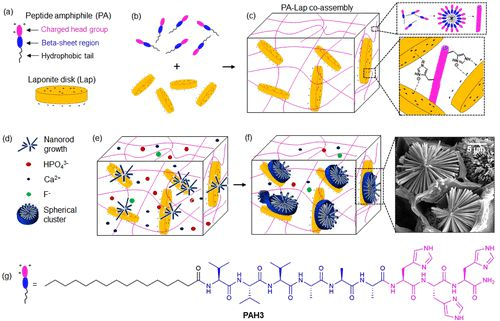Revascularization-Organic/Inorganic PAH 3-Lap hydrogel

De Novo Design of Functional Coassembling Organic–Inorganic Hydrogels for Hierarchical Mineralization and Neovascularization
Synthetic nanostructured materials containing organic and inorganic components provide a unique, powerful and versatile class of materials with unique but complementary properties of different components, a supramolecular system based on synthetic nanoclay (Laponite, Lap) and peptide) (PAs, PAH 3) designed to assemble into nanostructured hydrogels with high structural integrity and a range of biological activities. Spectral and scattering techniques and molecular dynamics simulation methods were used to confirm the electrostatic adsorption of PAH 3 nanofibers and consistent with the surface nanodiscs of Lap. Electron and atomic force microscopy also confirmed the increased diameter and surface area of the PAH 3 nanofibers after co-assembly with Lap. Dynamic oscillatory rheology shows that co-assembled PAH 3-Lap hydrogels show high stiffness and robust self-healing behavior, while gas adsorption assays confirm the stratified and inhomogeneous porosity. Furthermore, this unique structure within the 3D (3D) matrix provides spatial constraints for the nucleation and hierarchical organization of high aspect specific hydroxyapatite nanorods, making it a well-defined spherical cluster within the 3 D matrix. The suitability of the organic-inorganic PAH 3-Lap hydrogel was evaluated in vitro using human bone marrow-derived stromal cells (hBMSC) and in vitro using chicken chorioallantoic membrane (CAM). We show that organic-inorganic PAH 3-Lap hydrogel promotes human skeletal cell proliferation and, integrated with CAM after mineralization, is infiltrated by blood vessels, stimulates extracellular matrix production and promotes massive mineral deposition relative to control.
18915694570
Previous: BK Engineering Bacteri
Next: Revascularization-β-HS


